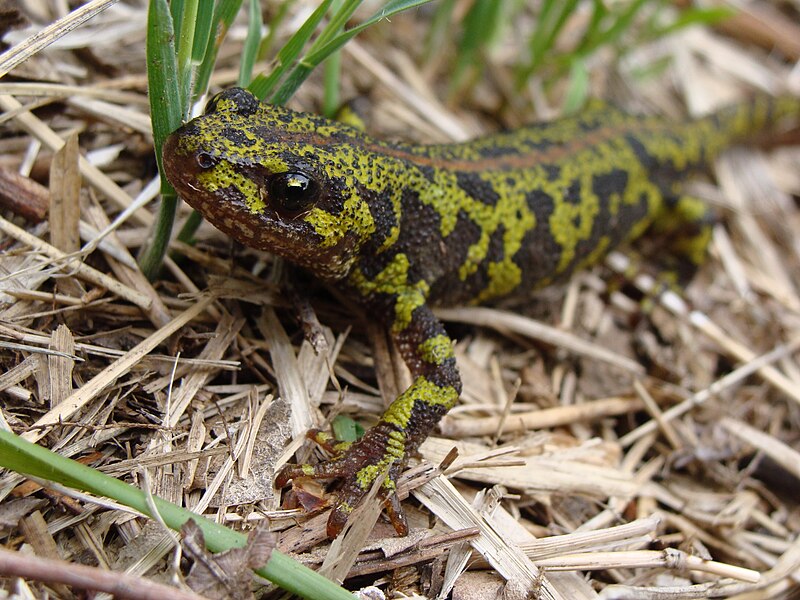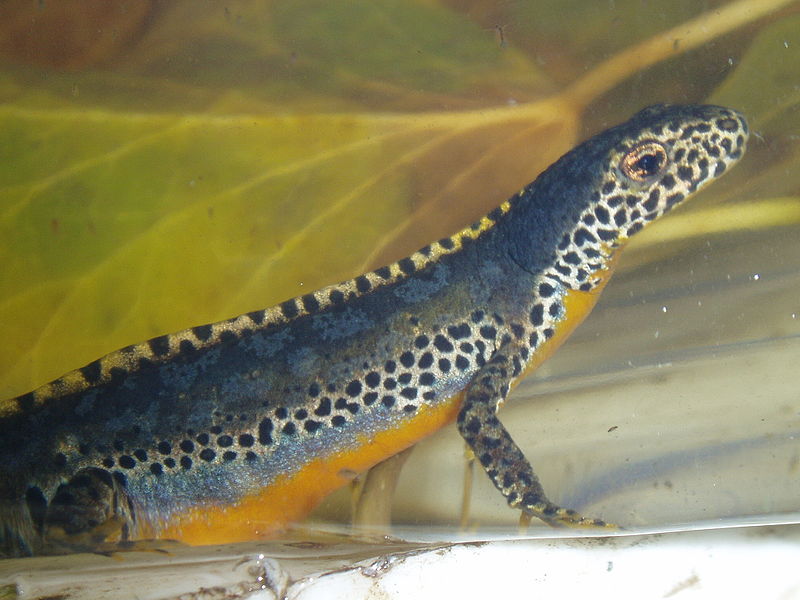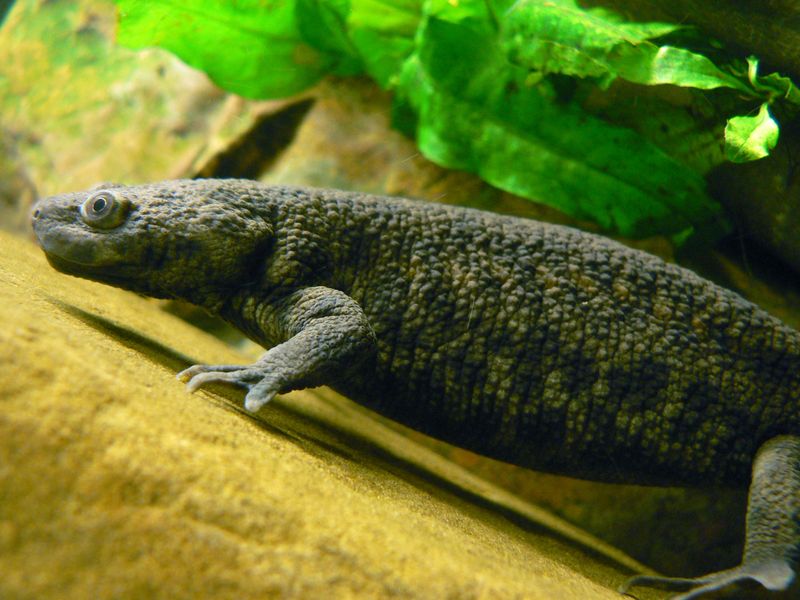
Basic Diet
Newt-feeding is simplified by the fact that nearly all species will take non-living foods…this is in sharp contrast to terrestrial salamanders, which generally consume live prey only.
Newt-keepers can capitalize on this by using Reptomin Food Sticks as the basis of the diet. I’ve used Reptomin since its introduction, and have found it to be the single best commercial newt food available. Reptomin Select-a-Food, which contains freeze dried shrimp and plankton, provides even more in the way of nutrients. You can use either for at least 60% of your newts’ diets.
Live Blackworms, Lumbriculus variegatus, are related to earthworms and commonly sold as food for tropical fishes. I experimentally raised the larvae of Mexican Axolotls and Spotted and Marbled Salamanders solely upon blackworms, and had excellent results. Avoid Tubifex Worms, which are harvested from polluted waters.
 Live Earthworms are a near-perfect food for most newts (and amphibians in general), and form the bulk of the diet of many of my terrestrial salamanders and frogs. Chopped worms can be given to larvae and small individuals, but whole, small earthworms offer more complete nutrition. Establishing an earthworm colony will assure a steady supply of tiny worms (please see article below).
Live Earthworms are a near-perfect food for most newts (and amphibians in general), and form the bulk of the diet of many of my terrestrial salamanders and frogs. Chopped worms can be given to larvae and small individuals, but whole, small earthworms offer more complete nutrition. Establishing an earthworm colony will assure a steady supply of tiny worms (please see article below).
Freeze-Dried Shrimp provide a large dose of Calcium and are relished by all newts. I prefer using freshwater shrimps, but marine krill has worked well for me in the past.
Small fishes and their fry are likely taken by many newts in the wild, and are a useful food source for captives; their Calcium: Phosphorus ratio is ideal for amphibians. Guppies will thrive and breed, albeit slowly, in room temperature waters if adjusted slowly. Healthy adults generally evade newts, but aged individuals and fry are readily captured. The same holds true for Swordtails and Platys, but these may out-compete newts at feeding time.
Treats and Extras
 The following can be offered on an occasional basis…there are many other options, so please write in with your own thoughts and experiences.
The following can be offered on an occasional basis…there are many other options, so please write in with your own thoughts and experiences.
ReptoTreat Superba Food Sticks
Snails – snails are useful scavengers in newt aquariums; eggs and small individuals will be consumed by many species.
Sowbugs, small crickets, moths – sowbugs are crustaceans and high in Calcium; other invertebrates may be offered as available; avoid mealworms, large crickets.
Freeze-dried and frozen bloodworms, Mysis shrimp, Daphnia, Gammarus and other foods marketed for tropical fish.
Further Reading
The Great Crested Newt: natural history and diet
Newts and Salamanders, an Owner’s Manual
Tritirus mamoratus image referenced from wikipedia and originally posted by Esv
Alpine Newt image referenced from wikipedia and originally posted by Anevrisme
Ribbed Newt image referenced from wikipedia and originally posted by Pengo
 That Reptile Blog – Reptile, Amphibian and Exotic Pet Care and Information
That Reptile Blog – Reptile, Amphibian and Exotic Pet Care and Information



I disagree. I can’t tell you how many new owners of recently-imported newts are unable to get their newts to eat non-live foods. Reptomin sticks seem to me a particularly poor recommendation as a first choice food.
My 3 most-recommended foods for newts are: earthworms, earthworms, and earthworms! The best non-live food for newts in my experience is frozen bloodworms.
Hello Jennifer, Frank Indiviglio here.
Thanks for your interest. I must stand by my recommendation as I’ve raised and bred a wide variety of species over the course of many years while using Reptomin as an important part of the diet. It is a standard newt food item in the zoos I’ve worked for, as well as in many others.
Shifting wild caught individuals to a dry diet takes some time, but I’ve been successful in doing so with any number of wild-caught adults (confiscated by US F&WS and housed at the Bronx Zoo)…i.e. Ribbed, Alpine, Marbled, Crested; except for individuals in their terrestrial phase, I cannot recall any that failed to accept Reptomin, trout chow and various frozen foods in time.
I find Reptomin useful for a variety of other creatures as well…a Xenopus muelleri in my collection, now 21-23 years old, consumes it as appx. 50% of his diet. Please see this article.
Earthworms are a fine food source for a great many creatures (please see this article). I’ve also had good results with bloodworms and other aquatic insect larvae, although I’ve not tried any as a dietary staple for other than a few poison frog tadpoles; please see this article for details.
Please let me know if you need any further information. Good luck and please keep me posted.
Best regards, Frank Indiviglio.
Dear Frank
I got my first two Mexican Axolotl and belive me, i am in seventh heaven!!!!
Two questions:
1. Why are meal wors to be avoided?
2. I read on qiute a view sites where the the genaral PH exceptance is higher than 7.2. You have mentioned a lower PH is recomended due to the gills of these wonderfull creatures. As they are not as fussy about hardness as Discus for instance, would a high PH of close to 8.0 be still OK (one site claims they can even take PH as high as 8.2!
I am looking forward to another of your so ever interrsting answers!
Best fishes
Gert from Namibia
Hello Gert,
Nice to hear about your new addition.
Mealworms have a thick exoskeleton and are difficult for most salamanders to digest; intestinal blockages are common. They also are not very nutritious; a poor Ca: phosphorus ratio and so on. Axolotls are adapted to take mainly soft-bodied invertebrates; small fishes should be offered on occasion, however, and reptomin and similar foods are fine. Please see this article for more info, and let me know if you need further details. Some related links below as well.
http://blogs.thatpetplace.com/thatreptileblog/2009/02/13/breeding-mexican-axolotls-ambystoma-mexicanum/#.UxD1CIVnupE
http://blogs.thatpetplace.com/thatreptileblog/2010/09/14/urban-amphibians-endangered-axolotl-population-found-in-mexico-city-park/#.UxD1OoVnupE
They can adapt to 8.0, I believe, but better to stay lower if possible.
Enjoy and pl keep me posted, Frank
Hallo Frank
Thank you once more for your helpful and interesting answer.
In the meantime I did offer my (+/- 8cm) Axolotls mealworm and I have to underline your statement.
As they are gulping in their food, the Axolotls where definitely struggling to swallow the mealworms as a whole piece and even more so they struggled to spit them out again!
I then fed them live mosquito larvae and they loved it!!! Although at first, they gulped the larvae on the fine gravel and unfortunately took in some gravel as well!
But to my astonishment, after a while, they seemed to start taking only the larvae that started to swim when stirred up by the Axolotls!
On another note I seem to be very lucky that my two guys are not troubling one another… I tried to furnish their aquarium with enough plants (vallisneria) stones and log to create enough boundaries but still they apparently “like” to be in one another’s company…?
Keep cool and best fishes
Gert from Namibia
Hi Gert,
Thanks for the feedback…I’ve noticed also that they reject hard-bodied insects. Mosquito larvae ideal, although not enough to support normal growth if that’s all they are getting. Try adding chopped earthworms or blackworms if available, guppies as hey get larger, chpped frozen prawn will be taken by most as well.
Be careful with sand…looks good, and many pass it when consumed, but lots of variables. Some folks drop earthworms into a sunken glass bowl to limit ingection. Always best to provide as much cover and barriers as possible. Even if cannibalism isn’t possible due to size, they routinely clip off gills and toes of tankmates…these grow back, but infection always a possibility,
Enjoy, best, Frank